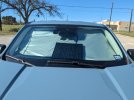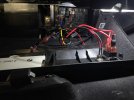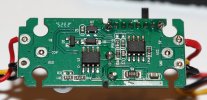kawayanan
New Member
Alright, I got some stuff to mess around with. 
As I mentioned, I use this is a pickup with a tri-fold hard bed cover. The way it fold up, there is a space on top of the back third once folded. It has foam bumpers to go between the top of the back section and the folded parts. The space between the foam bumpers is about 15" (I could in theory move them too), and the back section is also about 15" deep. This seemed like a perfect place to put a solar panel. It wouldn't be in the way, the bed cover could still be folded without moving or damaging the panel, and being behind the cab I don't think it should get too much wind when driving. I went looking for a solar panel that seem reasonable, not too expensive, and I wanted the frame to be black to not stick out too much. Wheat I found was this. It was small enough, black frame, and had a 50% coupon making it $27.50. It may not be the best panel, so I'm not recommending it - it just met my criteria.
I decided to change the connection type to MC4 solar connectors, partly to have better connectors, but also to make the connection to the PS easy. There are MC4 to barrel connection plugs available on Amazon and it was easy to find one that would work with the DC input on my PS. This one was $13.59 when I bought it (there are a bunch on Amazon though).
Here is what it looks like when checking it out.
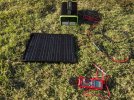
I tested it out quickly flat on the ground, at ~4:10pm (sun getting low on the horizon). When not connected to a load, the voltage from the panel was 20.0-20.8V (not sure of an easy way to check the voltage when connected to the PS). When connected to the PS, it woke it up as expected and the icons were showing it charging. The PS isn't like the nice ones that give you the power stats in and out, but my multimeter showed ~0.70-0.75 amps. If that's right and the voltage stayed at ~20V, it looks to be putting out 14-15W, which is honestly better than I expected for a cheap 20W panel off Amazon (and not with direct overhead sunlight). I think tomorrow I will try to check it with the sun overhead, and if I put the panel inside my windshield (just curious how much is lost going through the glass).
I'll still need to work out the mounting on my bed cover. The electrical connection on the back of the solar panel sits just proud of the frame, so it cannot be mounted flat. I'll have to get some L-channel to make some mounts and rubber grommets for the bolts and wires to go through the bed cover.
If my explanation above didn't make sense, here are some picture of how it should sit on the hard cover, and how it stays out of the way when it is folded up. I want to put the wire through under the panel.
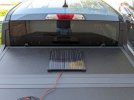
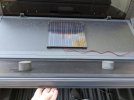
As I mentioned, I use this is a pickup with a tri-fold hard bed cover. The way it fold up, there is a space on top of the back third once folded. It has foam bumpers to go between the top of the back section and the folded parts. The space between the foam bumpers is about 15" (I could in theory move them too), and the back section is also about 15" deep. This seemed like a perfect place to put a solar panel. It wouldn't be in the way, the bed cover could still be folded without moving or damaging the panel, and being behind the cab I don't think it should get too much wind when driving. I went looking for a solar panel that seem reasonable, not too expensive, and I wanted the frame to be black to not stick out too much. Wheat I found was this. It was small enough, black frame, and had a 50% coupon making it $27.50. It may not be the best panel, so I'm not recommending it - it just met my criteria.
I decided to change the connection type to MC4 solar connectors, partly to have better connectors, but also to make the connection to the PS easy. There are MC4 to barrel connection plugs available on Amazon and it was easy to find one that would work with the DC input on my PS. This one was $13.59 when I bought it (there are a bunch on Amazon though).
Here is what it looks like when checking it out.

I tested it out quickly flat on the ground, at ~4:10pm (sun getting low on the horizon). When not connected to a load, the voltage from the panel was 20.0-20.8V (not sure of an easy way to check the voltage when connected to the PS). When connected to the PS, it woke it up as expected and the icons were showing it charging. The PS isn't like the nice ones that give you the power stats in and out, but my multimeter showed ~0.70-0.75 amps. If that's right and the voltage stayed at ~20V, it looks to be putting out 14-15W, which is honestly better than I expected for a cheap 20W panel off Amazon (and not with direct overhead sunlight). I think tomorrow I will try to check it with the sun overhead, and if I put the panel inside my windshield (just curious how much is lost going through the glass).
I'll still need to work out the mounting on my bed cover. The electrical connection on the back of the solar panel sits just proud of the frame, so it cannot be mounted flat. I'll have to get some L-channel to make some mounts and rubber grommets for the bolts and wires to go through the bed cover.
If my explanation above didn't make sense, here are some picture of how it should sit on the hard cover, and how it stays out of the way when it is folded up. I want to put the wire through under the panel.



